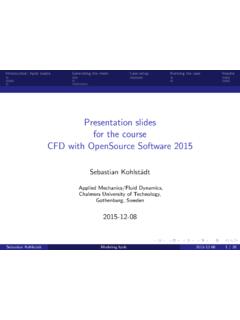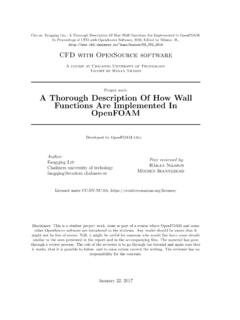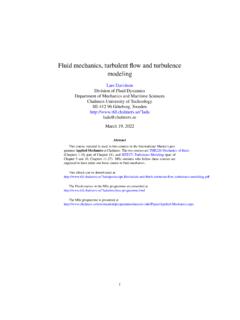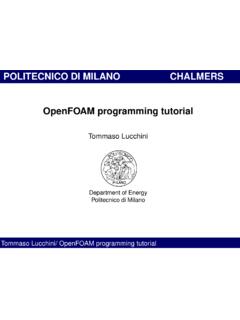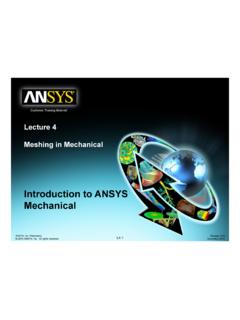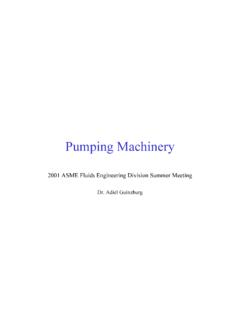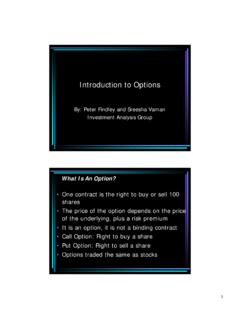Transcription of Basics of C++ in OpenFOAM - Chalmers
1 H akan Nilsson, Chalmers / Applied Mechanics / Fluid Dynamics189 Basics of C++ in OpenFOAMH akan Nilsson, Chalmers / Applied Mechanics / Fluid Dynamics190 Basics of C++ in OpenFOAM To begin with: The aim of this part of the course is not to teach all of C++,but to give a short introduction that is useful when trying to understandthe contents of OpenFOAM . After this introduction you should be able torecognizeand makeminormodificationsto most C++ features in OpenFOAM . Some books: C++ direktby Jan Skansholm (ISBN 91-44-01463-5) C++ how to Programby Paul and Harvey Deitel Object Oriented Programming in C++by Robert Lafore C++ from the Beginningby Jan SkansholmH akan Nilsson, Chalmers / Applied Mechanics / Fluid Dynamics191C++ Basics types Variables can contain data of differenttypes, for instance:int myInteger;for a declaration of an integer variable namedmyInteger, orconst int myConstantInteger = 10;for a declaration of anconstantinteger variable namedmyConstantIntegerwith value10.
2 Variables can be added, substracted, multiplied and divided as longas they have the sametype, or if the types have definitions on how to convert between the types. In C++ it is possible to define specialtypes(classes), and there are many types defined foryou in OpenFOAM . User-defined types must have the required conversions defined. Someof the types in Open-FOAM can be used together in arithmetic expressions, but not all of akan Nilsson, Chalmers / Applied Mechanics / Fluid Dynamics192C++ Basics Namespace When using pieces of C++ code developed by different programmers there is a risk that thesame name has been used for different things.
3 By associating a declaration with a namespace, the declarationwill only be visible if thatnamespace is used. The standard declarations are used by starting with:using namespace std; OpenFOAM declarations belong to namespace Foam, so in OpenFOAM we use:using namespace Foam;to make all declarations in namespaceFoamvisible. Explicit naming in OpenFOAM :Foam::function();wherefunction( )is a function defined in namespaceFoam. This must be used if any othernamespace containing a declaration of anotherfunction()is also akan Nilsson, Chalmers / Applied Mechanics / Fluid Dynamics193C++ Basics input/output Input and output can be done using the standard libraryiostream, using:cout << "Please type an integer!
4 " << endl;cin >> myInteger;where<<and>>are output and input operators, andendlis a manipulator that generatesa new line (there are many other manipulators). In OpenFOAM a new output streamInfois however defined, and it is recommended to usethat one instead since it takes care of write-outs for parallel akan Nilsson, Chalmers / Applied Mechanics / Fluid Dynamics194C++ Basics , main function All C++ codes must have at least one function:int main(){return 0;}in this case,maintakes no arguments, but it may (as in OpenFOAM applications). The main function should always return an integer, and default is0, so for the main functionit is allowed to write only:main(){} Code appearing after thereturnstatement is not executed!
5 !!H akan Nilsson, Chalmers / Applied Mechanics / Fluid Dynamics195C++ Basics , Example codeIn :#include <iostream>using namespace std;main(){int myInteger;const int constantInteger=5;const float constantFloat= ;cout << "Please type an integer!" << endl;cin >> myInteger;cout << myInteger << " + " << constantInteger << " = "<< myInteger+constantInteger << endl;cout << myInteger << " + " << constantFloat << " = "<< myInteger+constantFloat << endl;}Compile and run with:g++ -o basic1;./basic1H akan Nilsson, Chalmers / Applied Mechanics / Fluid Dynamics196C++ Basics operators +,-,*and/are operators that define how the operands should be used.
6 Other standard operators are:%(integer division modulus)++(add 1)--(substract 1)+=(i+=2adds 2 to i)-=(i-=2subtracts 2 from i)*=(i*=2multiplies i by 2)/=(i/=2divides i by 2)etc. User-defined types should define its operators. Comparing operators:< > <= >= == !=Generatesbool(boolean) Logical operators:&& || !(or, for some compilers:and or not). Generatesbool(boolean)H akan Nilsson, Chalmers / Applied Mechanics / Fluid Dynamics197C++ Basics functions Mathematic standard functions are available in standard libraries. They are thus not partof C++ itself. Standard librarycmathcontains trigonometric functions, logaritmic functions andsquareroot.
7 (use#include cmath;if you need them) Standard librarycstdlibcontains general functions, and some of them can be used forarithmetics. (use#include cstdlib;if you need them)H akan Nilsson, Chalmers / Applied Mechanics / Fluid Dynamics198C++ Basics if, for and while-statements if-statements:if (variable1 > variable2) {.. } else {.. } for-statements:for ( init; condition; change ) {.. } while-statements:while (.. ) {.. }break;breaks the execution ofwhileH akan Nilsson, Chalmers / Applied Mechanics / Fluid Dynamics199C++ Basics , Example codeIn :#include <iostream>#include <cmath>using namespace std;main(){float myFloat;cout << "Please type a float!}
8 " << endl;cin >> myFloat;cout << "sin(" << myFloat << ") = " << sin(myFloat) << endl;if (myFloat < ){cout << myFloat << " is less than " << endl;} else{cout << myFloat << " is not less than " << endl;};for ( int i=0; i<3; i++ ) {cout << "For-looping: " << i << endl;}int j=0;while (j<3) {cout << "While-looping: " << j << endl; j++;}}Compile and run with:g++ -o basic2; ./basic2H akan Nilsson, Chalmers / Applied Mechanics / Fluid Dynamics200C++ Basics arrays Arrays:double f[5];(Note: components numbered from 0!)f[3] = ;(Note: no index control!)int a[6] = {2, 2, 2, 5, 5, 0};(declaration and initialization)The arrays have strong limitations, but serve as a base for arraytemplates Arraytemplates(examplevector.)
9 Other:list, deque):#include <vector>using namespace stdThe type of the vector must be specified upon declaration:vector<double> v2(3);gives{0, 0, 0}vector<double> v3(4, );gives{ , , , }vector<double> v4(v3);Constructsv4as a copy ofv3(copy-constructor) Array template operations: The template classes define member functions that can be usedfor those types, for instance:size(),empty(),assign(),push_ba ck(),pop_back(),front(),clear(),capacity () (4, );gives{ , , , }H akan Nilsson, Chalmers / Applied Mechanics / Fluid Dynamics201C++ Basics , Example codeIn :#include <iostream>#include <vector>using namespace std;main(){vector<double> v2(3);vector<double> v3(4, );vector<double> v4(v3);cout << "v2: (" << v2[0] << "," << v2[1] << "," << v2[2] << ")" << endl;cout << "v3: (" << v3[0] << "," << v3[1] << "," << v3[2] << "," << v3[3] << ")" << endl;cout << "v4: (" << v4[0] << "," << v4[1] << "," << v4[2] << "," << v4[3] << ")" << endl;cout << " (): " << () << endl;}Compile and run with:g++ -o basic3.
10 /basic3 Note that the standardvectorclass isnotimplemented to be able to execute:cout << "v2: " << v2 << endl;Such functionality is available in akan Nilsson, Chalmers / Applied Mechanics / Fluid Dynamics202C++ Basics function implementation Example function namedaveragedouble average (double x1, double x2){int nvalues = 2;return (x1+x2)/nvalues;}takes two arguments of typedouble, and returns typedouble. The variablenvaluesis alocal variable, and is only visible inside the function. Note that any code after thereturnstatement will not be executed. A function doesn t have to take arguments, and it doesn t have toreturn anything (theoutput type is then specified asvoid).
